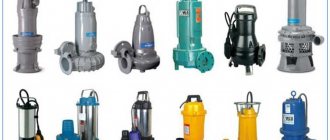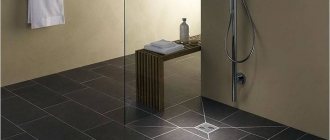Water supply is an essential component of comfortable living on a plot of land. However, most houses (especially dachas) do not have a centralized system, which creates a lot of trouble for residents. To ensure basic water needs (for hygienic, drinking, domestic, technical and other purposes), you will need to install a deep submersible pump in the well. This autonomous source will ensure a complete supply of water, as well as its uninterrupted supply.
Many people mistakenly believe that it is impossible to carry out these installation works without the involvement of professionals. In fact, this task seems difficult and impossible only at first glance. By taking into account some recommendations, using expert advice and knowing the basic nuances, you can perform high-quality, error-free and quick installation of equipment on your own.
How to install a surface pump in a well
The instructions indicate that surface pumps can be installed in a well if its depth is up to 20 meters. In this case, water flows to the distribution points directly from the well. The connection diagram for a surface pump to a well includes the following equipment:
- A centrifugal pump that lifts water and supplies it to the house.
- The hydraulic accumulator softens the hydraulic shock. It consists of two parts separated by a membrane.
- The electric motor is connected to the pump and pressure switch.
- The pressure switch controls its level in the system. If there is a strong drop in pressure, the relay starts the motor, and if there is too much pressure, it turns it off.
- The pressure gauge is used to determine the value and regulate pressure.
- Water intake system with check valve.
- The main connects the pump and the water intake.
Installation diagram of a surface pump for a well
When installing a surface pump or station, you need to adhere to some rules that will ensure proper operation of the equipment:
- Stable water suction is ensured by close proximity to the well.
- The room must be ventilated, warm and dry.
- The location should not be cramped. During operation, preventive and repair work will be required.
- The room must absorb noise emitted by pumping equipment.
Suitable installation locations may include:
- The room is inside the house, but with poor sound insulation this will be a big disadvantage of the installation.
- Basement. In the absence of heating and insulation of floors and walls, additional funds must be spent on their preparation.
- Special well. But here it is difficult to maintain the required level of pressure and repair work is difficult.
- Caisson. The basic rule is the correct depth of the special installation site.
Tip: To install a pumping station for a well, it is best to arrange a separate room.
Additional materials
The list of required materials depends on which borehole pump will be installed. For surface models, you will need a check valve with a filter and a suction hose to immerse into the shaft with a sufficient degree of rigidity. When using an ejector model, you will need to purchase two pipes with a diameter corresponding to the inlet holes of the pump part.
To connect a submersible well pump with your own hands, you will need to purchase the following:
Cable for fixing the pumping unit in the shaft. If the equipment is already equipped with a cable, you should check its length, make sure it is strong and resistant to moisture. The cord must support 5 times the weight of the pump.
Electrical cable. The length of the cable is calculated so that it does not sag, but is not stretched either.
Pipe for connecting to the water supply. Typically, installation of a pump in a well is carried out using plastic pipes with a diameter corresponding to the outlet pipe. When choosing pipes, take into account the distance to the water surface: at a depth of up to 50 m you can purchase plastic designed for a pressure of 10 bar, from 50 to 80 m - up to 12.5 bar, and above 80 you should choose a pipe that can withstand a pressure of 16 bar. The pump can also be connected to the well using metal pipes, but this option is more expensive, and the presence of connections between individual elements increases the likelihood of loss of tightness of the supply pipe and the formation of leaks.
A strong steel assembly on the head of the shaft to secure the pump.
Fastenings for fixing the electrical cable on the supply pipe.
Features of installing a well pump
Advice: The device should be installed below the water level in the well, but more than one meter from the “well supply” hole. In this case, the pump will be safe from the penetration of soil or sand particles into it and the possibility of overheating.
To install the pump in a well you will need:
- Plastic pipe. The element is lowered into the well along with the device, and during operation water will rise through it.
- Cable for insurance.
- Cable for connecting the motor.
Tip: Before installing a well pump, you need to thoroughly clean the installation site: pump out water from the well until the sand and silt completely disappear. To protect the pump from water hammer, it is necessary to install a check valve on the equipment.
You can install a well pump only after checking and adjusting the pressure that has established in the pressure tank. Its value should be 0.9 part of the switching pressure. Constantly pumped water cools the engine, which provides it with protection from overheating, and therefore premature failure. Regardless of the type of equipment selected, during installation of a well pump, it is necessary to check the operating point under different modes. To do this you need:
- Measure the design value of the water supply flow by measuring the filling rate of the volume.
- Take the pressure reading.
- Determine what current consumption is.
Moreover, if even one indicator is higher than the factory data, it will be necessary to close the valve, this will create additional resistance and will contribute to the correct establishment of the operating point.
Electrical diagram for connecting a pump for a well
What should a good pump be like?
A centrifugal submersible pump is used to lift water from the well. To select a unit, you need to know the parameters that it must meet:
- The productivity of the central pump cannot exceed the flow rate of the well. Otherwise, the deep pump will remain without water and fail.
- The pressure should be 2.5-3 kg/cm² higher than the losses in the pipeline. Every 10 m of vertical section corresponds to 1 kg/cm², and horizontal – 0.1 kg/cm².
- The pump flow is designed to compensate for the specific water consumption in the house. The optimal value is 1.5-2 m³/h.
- The pump diameter must provide sufficient clearance between the casing and the casing wall to allow water to flow in and prevent shock during start-up.
There is no need to buy a unit with much larger parameters than necessary. This is an extra waste of money and an additional load on the house electrical wiring. A unit that is too low will work with overload, which will lead to breakdown.
Relay selection
When choosing a hydraulic relay, you are guided by its range in the water supply; the standard value is 1.5 - 3 bar. When connecting using a pressure gauge, adjust it using the adjusting screws. Do the same with the dry-running relay, setting it to turn off the power when the pressure in the line is less than 1.5 bar. If a private house has a high number of floors, then to supply water with the required pressure to the upper floors, the relay is additionally adjusted, increasing the upper and lower response thresholds.
For example, if the height of the rise to the upper floors is 5 meters (1 bar corresponds to 10 meters of vertical water column), then 0.5 bar is added to the upper and lower response limits and the resulting response range is from 2 to 3.5 bar . The brand chosen for water supply at home must have the appropriate pressure range according to the passport.
Rice. 8 Pumping units with floats and electrolytic sensors
Types and depths of wells
The depth of immersion of the pump into the well largely depends on its parameters; when drilling, three main types are distinguished: Abyssinian, on sand, and artesian.
Abyssinian well
Abyssinian is the most affordable option from a financial point of view; its depth rarely exceeds 10 meters; the intake is carried out from the first aquifer (upper water). Drilling the Abyssinian is often done with your own hands using homemade drills; usually its channel pipe has a small diameter of 1.5 - 3 inches and is designed for water intake with a surface electric or manual mechanical pump.
The pipes lowered into the Abyssinian are equipped with a needle-shaped filter at the end; due to its light weight, it is located directly in the aquifer without sinking to the sandy muddy bottom - thanks to this, the water in the Abyssinian does not have sand and clay impurities. Although the Abyssinian spring has fairly clean water, the well is rarely used to provide a constant water supply to a residential building - its flow rate is too small.
Well in the sand
If water-bearing strata are not found at a shallow depth in the area, a sand well is drilled until water is found, the depth of which lies in the range from 15 to 60 m with an average of about 30 meters. This type is most common in individual water supply; when drilling, a column of plastic or steel pipes with a diameter of 100–160 mm is lowered into the shaft, which, due to its high weight, rests on the bottom of the water-bearing formation.
A perforated water filter is installed at the end of the column to purify water from sand and clay particles, but in many cases this is not enough and additional elements are installed in the pipeline that filter the water (sand, coarse and fine filters).
The use of pumping equipment for intake must take this factor into account (a large number of sand particles), so modifications are usually chosen for working with contaminated water. A well on sand, unlike an Abyssinian, has a higher flow rate and, most importantly, is suitable for water supply to an individual residential building, although its service life is short (depending on the size of the sand fractions) and averages about 5 years.
Rice. 2 Types of wells for installing a submersible pump
Artesian well
When searching for sources of artesian water, drilling is carried out to an aquifer with a calcareous bottom, while the depth of the borehole channel during domestic drilling can reach up to 200 m, and in industrial sources a threshold of about 300 m or more is considered normal. During installation, the casing with a special filter for large particles rests on a solid limestone bottom, which is free of clay and sand. Thanks to this, water from great depths is crystal clear and the only drawback is its high iron content. The deeper the aquifer is, the greater the pressure exerted on it by the higher layers of the earth - as a result, artesian springs have the highest flow rate and a constant static level.
Pros and cons of surface pumps
Surface pumps have many advantages:
- Compact overall dimensions;
- Light weight;
- Affordability;
- Easy to install, operate and maintain. Installing a surface pump does not require special knowledge, skills and experience;
- Ability to work with a water layer of less than 80 cm. In such conditions, submersible pumps can no longer operate;
- Cooling by air, and not by water, like submersible ones;
- High water pressure;
- High efficiency;
- No need to supply electricity to the water intake;
- High reliability and durability;
- Stable operation even in the presence of air pockets in the system.
Also, surface pumps (as a class of equipment) have a number of disadvantages:
- Sensitivity to the presence of sand, impurities and other water contaminants;
- The maximum depth from which water can be raised is about nine meters;
- When using an ejector, the reliability and performance of the system are significantly reduced;
- Noise. It is better to allocate a separate room for the operation of the surface pump;
- The need to fill the suction line with water.
WINTER OPTION WITH INSTALLATION OF METAL CAISSON
A caisson is an underground metal structure (chamber) located directly above the well, welded hermetically to the casing, and performs several functions:
- Protects the wellhead from flooding and pollution by flood waters.
- Protects the system from freezing and makes it possible to operate the well all year round, and not just in the warm season.
- Makes it possible to place equipment (battery tank, control unit and cable and pipe distribution) directly above the well, in the absence of a special room in the house.
- Provides convenient access to equipment for inspection, repair or maintenance.
| When constructing a turnkey well, the caisson neck cover is at least 5 centimeters above the ground. | When constructing a well in winter, the caisson neck is additionally insulated. | When constructing a turnkey well, all water-lifting equipment is installed in the caisson. |
Rules for installing a surface pump
It is not practical to install surface pumps on deep hydraulic structures. When diving below 8 m, such devices fail. In small wells, their installation is justified due to their lower price than submersible options.
The installation procedure consists of the following sequential steps:
- A separate room is prepared to house the equipment. You can allocate space in the caisson for a surface pump.
- A rubber sleeve is placed on the suction pipe. Its length should be sufficient to connect to the aquifer.
- A check valve is fixed on the opposite side of the hose. It performs the function of stopping the drainage of liquid when the mechanism is turned off.
- A strainer is mounted on top of the valve device. It sifts out silt fragments and sand granules.
- The end of the elastic sleeve is lowered into the water.
The process ends with a trial run.
WINTER OPTION WITH INSTALLATION OF WELL ADAPTER
The cost of installing a water well according to the “winter option” can be reduced by refusing to install a caisson, “replacing” it with a well adapter, which is installed on the casing and allows you to bring the water pipe below the freezing level.
However, the downhole adapter has many disadvantages (complexity of installation on a two-pipe well, difficulties with lifting a pump located at a depth of 60 m, extreme difficulty in installing a pumping unit at a depth of over 60 m, etc.).
Another inconvenience is the need to place a hydraulic storage tank and automatic control in the house. Having weighed all the pros and cons, the conclusion does not allow us to talk about the advantage of the downhole adapter (except for the price) over the caisson.
| The downhole adapter is installed at a depth of 1.8 meters, and the well cover covers the casing. | To construct a well without a caisson, a well adapter and a well cap are used. | To set up a turnkey well, you need a high-quality well adapter and cap. |
SUMMER OPTION FOR WATERING AN AREA WITH INSTALLATION OF A WELL CAP
If you are going to use the well exclusively for summer irrigation, then the option for its arrangement will be the least labor-intensive and, accordingly, the cheapest.
After all, you only need to install a pump with a water-lifting pipe and a well head.
If desired, you can install compact automation that allows you to control the well pump depending on the water intake, without using bulky hydraulic storage tanks.
| Summer arrangement of a well for irrigation. | Summer construction of a water well. | Summer well construction. |
| Summer well construction without a caisson. | Summer well construction price. | Summer well construction on a turnkey basis. |
Installation of industrial well pumps
Installation of industrial equipment with a capacity of up to 15 m3/hour at depths of up to 100 meters can be carried out on HDPE 50 and HDPE 63 pipes.
If the electric motor is of greater power or greater depth, then it is recommended to install it on metal pipes with a diameter of 89 mm or more, connected with threaded connections through couplings. Since a torque is generated when powerful electric motors are turned on, the threaded connections are protected from spontaneous unwinding by spot welding.
Installation is carried out using lifting equipment. Sometimes electric winches are provided at water intake units, with the help of which they lift the well pump in cases where replacement is necessary.
For powerful equipment, cast-in cable couplings are used.
Installation is carried out in a new well or in an old one when replacing equipment. In the second option, it is allowed to use some communications that were already in operation: pipes, safety ropes, cables, etc. It is necessary to ensure their integrity and performance, and it is recommended to replace the connecting fittings with new ones.
Prices for installation of pumping equipment
Below are typical estimates for the installation of pumping equipment (installation of a caisson or well adapter, well pump and automation) at various pump installation depths: from 20 meters to 100 meters in increments of 10 meters.
The cost of installing a well pump, caisson and automation includes transportation costs up to 30 kilometers from the Moscow Ring Road.
Price table for well construction
| Pump installation depth | Construction of an artesian well | |||||
| With caisson | With borehole adapter | |||||
| rub. | rub. | rub. | rub. | rub. | rub. | |
| 20 meters | 83180 | 87975 | 117240 | 57800 | 62595 | 100560 |
| 30 meters | 88180 | 93125 | 120240 | 62800 | 67745 | 103560 |
| 40 meters | 91080 | 96025 | 127713 | 65700 | 70645 | 111033 |
| 50 meters | 96230 | 100725 | 140919 | 70850 | 75345 | 124239 |
| 60 meters | 102530 | 107025 | 150609 | 77150 | 81645 | 133929 |
| 70 meters | 107230 | 115425 | 153859 | — | — | — |
| 80 meters | 110130 | 118325 | 158873 | — | — | — |
| 90 meters | — | 121225 | 162123 | — | — | — |
| 100 meters | — | 124125 | 165373 | — | — | — |
Installation of a submersible electric pump for installation in a well
To install a submersible electric pump in a well, work is performed in the following order:
- Screws a plastic adapter coupling into the outlet of the unit to connect the pressure pipeline. If there is no built-in check valve, install your own, mounting it first at the outlet of the electric pump, then screw on the fitting for connecting HDPE pipes.
- They attach a pipe to the pump and fix it with a plastic cuff, thread a cable through the ears of the housing and connect its ends at the outlet using two special clamps, the free end is screwed to the main cable with electrical tape.
- Connect the power cable, cable and pressure hose together using electrical tape or zip ties in 1 meter increments, making sure that the power cord is secured without tension.
- The electric pump is lowered into the well to a predetermined depth. To do this, measure and cut the pressure pipe to the required length, insert it into the head, to which the cable is tied.
- After a dive, you can immediately check the operation of the electric pump without connecting to the pipeline, if the liquid supply corresponds to the passport data, connect the entire water line and then monitor and regulate the operation of the equipment with automatic devices.
Rice. 8 Preparing the downhole electric pump for immersion
To connect a well pump to a water supply system, devices are used that automate its operation, prevent frequent startup and reduce the load on the line. They can be independently assembled in one module, installed in a living space, or left in a caisson pit with a borehole head.
Installation stages
Preparation of the suspension system.
Installation begins with assembly: a check valve is installed on the inlet pipe to prevent the outflow of water from the system when the engine is turned off, then, if necessary, a cup-shaped filter is installed to prevent abrasive impurities from entering the working part of the installation.
The assembled unit is connected to the supply hose using an adapter. To ensure tightness, it is recommended to use winding. The fastening cord is pulled through the eyes provided in the housing and securely fastened. If an electrical cable is not provided in the design, it will also need to be connected to the device. In this case, it is very important to provide reliable protection against moisture penetration: the connection is insulated with a heat-shrinkable tube, and on top of it - a waterproofing sleeve.
The pipe, hose and cable are straightened along their entire length, and then connected together using clamps or clips, making sure that the cable is positioned more freely
Lowering the device into the shaft
After preparing the suspension system, you can proceed to lowering the unit into the well. Perform it slowly and extremely carefully, trying to ensure that the body does not come into contact with the walls of the casing pipe. To protect the device and the walls of the shaft from damage, you can put a protective ring on the housing. You only need to hold on to the fastening cable, while making sure that the hose and electrical cable are not too tight.
There is little space between the walls of the casing and the pump. Therefore, it is better to release the submersible pump into the well very carefully
The depth of immersion depends on the filling of the well and the manufacturer’s recommendations. Before performing work, you must carefully read the instructions. As a rule, the optimal distance to the bottom should be at least 1 m; with a lower location, the likelihood of abrasive particles getting inside the device increases. The recommended distance from the top of the body to the water surface is at least 50 cm. After the pumping unit reaches the recommended depth, the cable is secured to the frame.
Connecting a well pump
Before connecting the pumping equipment, a trench is dug from the house to the well, the depth of which will be greater than the freezing depth. The supply pipe and electrical cable are laid in the trench. If it is not possible to install communications at the same depth into the house, the exit located above the freezing level should be well insulated.
The connection diagram for a well pump is the same as for surface models: a hydraulic accumulator with an automation unit and filters for water purification are connected to the supply pipe, the cable is connected to a household power supply.
Proper installation of a pump in a well with your own hands will ensure long-term operation of the equipment and uninterrupted supply of water to the water supply system of the house. When replacement or preventative maintenance is required, the pump can be easily lifted to the surface and lowered back into the shaft.
Connecting a deep-well pump to a water supply system
When installing an individual water supply system, even at the stage of drilling operations, you should know the diameter and material of the pipeline, the depth of the water line, the operating pressure in the system for which the equipment is designed. When installing and turning on the water supply, follow the following recommendations:
When using a plumbing system in winter, you will have to take measures to protect it from the cold. Typically, pipes are laid underground and they must exit from the well head, so a caisson pit will be needed to install and maintain the equipment. To make it more convenient and reduce the depth, the water line is insulated and heated with an electric cable.
Rice. 6 Assembling a pumping station with your own hands - main steps
- When determining the immersion depth of the electric pump, set the dynamic level with the equipment turned on and suspend the unit 2 meters below the set mark; the minimum distance to the bottom for deep models is 1 meter.
- When using sand wells, it is necessary to install sand filters or rough cleaning filters in the water line in front of the equipment.
- Electric pumps change their pumping efficiency when the supply voltage changes, so for stable operation it is better to purchase a voltage stabilizer and connect the equipment to it.
- For ease of operation and maintenance, the pumping station is often assembled with your own hands. A pressure gauge and pressure switch are mounted on the hydraulic accumulator using a standard five-inlet fitting, but since there is no pipe for attaching the dry-running relay, it will have to be installed on an additional tee.
- Often electric pumps have a short power cable, not long enough to connect to the mains. It is extended by soldering a similar one with further insulation of the connection point with a heat-shrink sleeve.
- The presence of coarse and fine filters in the water supply system is mandatory. They must be placed before the automatic control system, otherwise the ingress of sand and dirt will lead to their incorrect operation and breakdown.
Rice. 7 Placement of automatic equipment in a caisson pit
Dismantling the deep-well pump
The need for dismantling due to pump failure may arise for a number of reasons, the most common of which are:
- incorrect installation of a submersible pump in a well;
- incorrectly selected elements of automatic control of pumping equipment;
- incorrect choice of the hydraulic machine itself based on its power.
So, if a pump, initially designed to service wells with a depth of no more than 50 m, is used to lift water to a height of about 80 m, then repairs to such equipment may be required after just a few months of its operation. The automation of this pump, configured for a certain pressure of the pumped liquid medium, simply will not periodically turn off the device, as a result of which it will work with constant overloads and, accordingly, will quickly fail.
Deep pump removed from a well
When a broken deep-well pump requires dismantling, it is better to invite qualified specialists to carry out this procedure. If you have studied theoretical material on this topic and watched videos shared on the Internet by users of submersible pumping devices, you can dismantle it yourself.
Installing a pump in a well
An important point when carrying out water supply work for a country house is the proper installation of the pump in the well. If the equipment is installed correctly, this is a guarantee of its long and uninterrupted operation.
Despite the fact that there is nothing complicated in installing a pump in a well, there are also some nuances that should be taken into account before starting work.
Important criteria when selecting water supply equipment
If the water supply equipment was selected incorrectly, installing a well pump can be a rather difficult task. The parameters that must be taken into account when choosing pumping equipment include the following:
- Dynamic and static level of a water artesian well. You can find this information in the installation passport. If you do not have such data, for example, due to the loss of documents, do not panic - this information is restored experimentally;
- To calculate the required volume of water that must be provided by the installed equipment, count the number of water consumption points. These include a sink, bathtub, shower, toilet, washing machine, dishwasher, etc.;
- Distance between the house and the water trunk.
What are the dangers of unqualified installation of a pump in a well?
If errors were made during the installation of downhole equipment or low-quality materials were used, this can cause a number of negative consequences. There are often cases when work performed by non-professionals leads to breaks in water-lifting products, the impossibility of dismantling when replacement is necessary, as well as premature breakdowns of pumps.
The first two scenarios, when the old equipment cannot be removed from the well, jeopardize the possibility of its subsequent use. Because of this, all the work has to be done anew: they drill another well, install a new caisson, since using the old one is impractical, and install new equipment.
Choosing a pump for a well
Installing a pump in a well often begins with choosing a good pump. The choice can be influenced by many factors, including reviews from users, acquaintances, relatives, personal experience, advertising, and the like. In this regard, when choosing pumping equipment, consider the following points:
- choose exclusively from downhole-type centrifugal units, since other types, in particular vibration, are intended for other operating conditions. The price of such devices is the lowest on the market, and the quality is correspondingly the same;
- One of the most important characteristics is the performance of the pump, which, first of all, must meet your needs. By performance we mean the number of liters of water that the device can pump in one hour. You need to rely on a level of productivity that will ensure an uninterrupted supply of water to the target locations;
- Also, the diameter of the pump housing is considered important. This value must correspond to the internal diameter of the casing pipes, which are the walls of the well. Here it is necessary to take into account that the closer to the bottom of the well, the smaller its diameter.
Types of pumps for wells and their functions
Pumps for supplying water from a well can be immersed in narrow wells to great depths or mounted on the surface. The operating principle of the device and its installation is as follows:
- Its main elements are impellers mounted on one shaft.
- Their rotation occurs in diffusers, which ensures the movement of liquid.
- After the fluid passes through all the wheels, it exits the device through a special discharge valve.
- Fluid movement occurs due to pressure differences, which are summed up across all impellers.
There are several types of such equipment:
- Centrifugal. Such a pump allows the supply of clean water without large contaminants.
- Auger. This is the most common device, capable of pumping liquid with an admixture of particles per cubic meter of no more than 300 grams.
- Vortex. Transfers only water purified from contaminants.
Despite the differences, all types of pumps serve to perform similar functions:
- Supply groundwater to private houses and cottages.
- Participate in the organization of irrigation systems.
- Pump liquid into tanks and containers.
- Provide comprehensive water supply in automatic mode.
When choosing a pump for a site, the following criteria are taken into account:
- Initial equipment dimensions. They need to be taken into account to ensure certain technological tolerances when placing the pump in the well.
- Power of the electricity source. Borehole pumps are manufactured single- and three-phase.
- Device power. This parameter must be determined in advance based on the calculated pressure and water consumption.
- Pump cost. In this case, it is necessary to choose the right price-quality ratio of equipment.
Types of household pumps
Pumps for wells are divided into submersible and surface. Such units have some advantages over others:
- Large water intake depth, which is inaccessible to any other type of pump.
- Ease of installation.
- No rubbing parts.
- Low noise level.
- Long service life.
The photo shows the types of submersible borehole pumps.
Submersible Well Pumps
Advice: It is very important to ensure that the equipment is properly and correctly arranged and to use only high-quality materials. Violation of installation technology or the use of poor materials can lead to:
Violation of installation technology or the use of poor materials can lead to:
- Pump breakage.
- Its premature failure.
- When dismantling, it is impossible to lift the pump.
Recommendations for choosing a pump for a well
Among the various types of pumping equipment used for pumping water from a well or well, submersible devices are the most popular. This popularity is explained by a number of advantages of submersible pumps, which include:
- no noise during operation;
- the ability to ensure uninterrupted water supply from a serviced well;
- ease of installation;
- the ability to provide water supply from wells of considerable depth;
- compact dimensions;
- no need for additional cooling of the drive motor;
- anti-corrosion properties of the materials from which the body is made.
When choosing such a device, you should pay attention to such parameters as:
- the total demand of water intake points for water, which the selected pump must provide;
- characteristics of the well from which water is to be pumped (diameter and depth);
- geological data of the area where the well was drilled (depth at which groundwater is located, soil type, etc.);
- the presence of a power source at the site where it is planned to install pumping equipment.
The main technical characteristics by which pumping equipment is selected are:
- the performance of the device, which characterizes how much liquid it is capable of pumping per unit of time;
- pressure (this parameter, measured in meters of water column, indicates to what height and distance the pump is capable of transporting liquid through the pipeline system).
This approach when choosing pumping equipment will give you the opportunity to further modernize your pumping station if the need arises.
Installing deep-well pumps, as a rule, does not cause any particular difficulties; it can be done even without experience in carrying out such procedures. When operating submersible pumps, as well as any other type of pumping equipment, one should not forget about their regular maintenance, which will significantly extend the life of their trouble-free use.
Which pump is suitable for a well?
The choice of pumping equipment begins with determining the type of model. All pumping units are divided into surface and submersible: the former are installed in close proximity to the water source, and the latter must be completely immersed in liquid during operation. Surface models are easy to maintain and their cost is somewhat lower, however, most of these units are designed for a suction depth of 7-9 meters. In addition to conventional surface pumping stations, ejector-type installations are produced that are capable of lifting water from a depth of up to 25-40 meters. Their design requires immersion into the well of not one, but two pipes - suction and pressure.
For deep wells, submersible models are considered a more suitable option. When choosing an electric pump, you need to pay attention to the operating principle of the equipment. It is not recommended to lower vibration devices into the shaft. Installing such a pump in a well will lead to erosion and siltation of the source.
In cases where there is a significant amount of abrasive impurities in the water, you should opt for screw or screw pumps. They are not very productive, but are resistant to sand, clay and lime. If the water contains no more than 0.15% solid particles, it is best to purchase a centrifugal unit. The design of a centrifugal well pump allows the supply of large volumes of liquid to a pressure height of up to 100 meters or more.
Many manufacturers produce models specifically designed for use in deep wells. They are distinguished by smaller body sizes, have protection against engine overheating, and are often additionally equipped with an electric cable and cable, the length of which corresponds to the maximum immersion depth.
Surface pumps are easier to install and cheaper than submersible models, but they are only effective for wells up to 8 meters deep
An important parameter when choosing a model is the diameter of the case. It should be 15-20 mm smaller than the internal dimensions of the casing pipe. Otherwise, the equipment may malfunction and fail much earlier than the time stated by the manufacturer. You should also pay attention to the power supply features of the unit. For domestic supply, the power of single-phase installations is quite sufficient.
How to Determine the Required Source Depth
The borehole pump must be installed at a certain depth of the water source. When using a well as a source of water supply, the static and dynamic levels of the location of the pumped liquid medium in it are taken into account. The static level is understood as the distance at which the surface of water, in a calm state, is located from the surface of the earth. At the dynamic level, water is in the well after it begins to be pumped out.
Dynamics of a water column in a well
In order for submersible pumping equipment to function effectively and be cooled efficiently by the liquid medium it pumps, it should be located in the well at a level at least 30 cm below the dynamic level. If the thickness of the water layer allows, then it will be better if the deep pump is installed at a level located 2–3 m below the dynamic level. It should be taken into account that the pump installed in the well should be located at a distance of at least 1–2 m from its bottom.
Preparing to install the pump
Also, the choice of pump will depend on what performance you need. After all, if this is a residential country house, then you need constant water pressure, without interruptions.
If this is just a dacha in which you live infrequently, then a lower power will suit you. In order for the well pump to serve you for a long time, be sure to use it according to the technical specifications, i.e. buy for the depth at which it will be used.
If the soil quality is not good, then it is better to protect the well with concrete rings, creating a so-called “corridor” that will prevent soil destruction. The casing pipe is selected according to the diameter of the pump.
Also consider how the pump will be connected to the electrical network. The cable should be in a relaxed state, not stretched.
Water from the pump rises through pipes, most often plastic. It is plastic that is more durable: it has a good service life, it does not rot and is not susceptible to corrosion.
In addition to all of the above, you will need clamps with which to secure the electrical cable through the pipe, a pressure gauge, a check valve and a shut-off valve.
Before installing a pump for permanent use, first pump the dirty water from the well using a cheap pump.
The deep-well pump is installed directly in the well, thereby not requiring a separate space.
First you need to assemble the entire structure, which will subsequently be immersed in the well.
The pump is connected to: water supply pipe, electrical cable, safety cable.
What is well automation?
Automatic control systems include electronics (pressure switch, idle speed, flow), pressure gauge, accumulator or modules in which these elements are combined - all of them are responsible for the optimal functioning of the water main.
In the water supply line, automation performs the following role:
- Controls the electric pump, turning it off as the line fills. In high-tech systems, instead of turning it off, it is used to adjust the rotation speed of the electric motor.
- Protects the water main from water hammer and helps create some water reserves in the event of equipment breakdown or power outage.
- Includes protective devices for the pump that interrupt the flow of electrical current to it in the event of a lack of water at the source.
Rice. 2 Example of a borehole water intake source
Recommendations for pump placement and positioning
When calculating to what depth to immerse the pump in the well and the location of the pump in the well, it is useful to follow the following recommendations:
- The electric pump should not come into contact with the walls of the column, so it is hung strictly in the center of the head.
- When the electric pump is lowered into a well in sand below the dynamic level, it is better to make the distance from the surface of the water a little more than recommended, for example, 5 meters. This will help to avoid the unpleasant consequences of a situation when, during operation, the source silts up, its flow rate and, accordingly, the dynamic threshold decreases. In order to lower the electric pump deeper in the future, you will have to lengthen or change the water pipe and cable cut to fit the head - this will lead to unjustified financial expenses.
- If, according to the parameters of the well, the electric pump must be located in the bottom area, it is better to use screw types - they cope better with pumping contaminated water, and replacing their simple parts is cheaper.
Rice. 9 Lowering the pump into the well
When placing an electric pump in a well, it is advisable to use such characteristics as dynamic and static level. Lowering the pumping equipment slightly below the dynamic mark contributes to less load on the body and working mechanism of the unit, the intake of cleaner water from the source, saves materials and simplifies maintenance.











